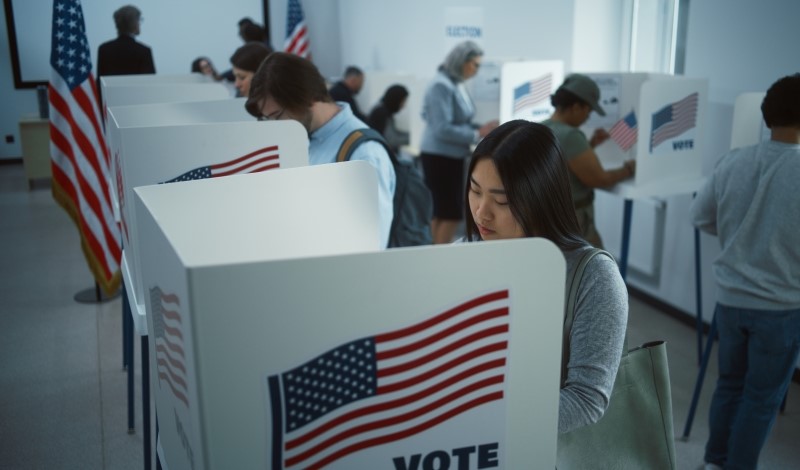
Scholars discuss issues affecting the 2024 U.S. presidential election.
Analysts predict that the 2024 U.S. presidential election will be close, likely coming down to the results in seven battleground states. Yet voters from three of these states—Wisconsin, North Carolina, and Georgia—will have less access to polls than they had in 2020. Recent concerns that North Carolina’s election laws may limit voting access for victims of Hurricane Helene prompted calls for the state’s election board to take emergency action to ensure that these individuals may still cast their votes.
The right to vote, considered essential to the functioning of democracy in the United States, has been heavily regulated since its inception. When the U.S. Constitution was ratified, the framers granted states the authority to determine their own standards and restrictions on voting—a decision that led to widely divergent approaches to who could vote.
In the 18th century, white male landowners became the first group granted voting rights.
After the Civil War, Congress passed the 15th Amendment reportedly to prevent states from denying or abridging the right to vote based on race or past enslavement. The goal of this Amendment was to enfranchise all formerly enslaved men. But states found loopholes allowing them to legally restrict voting access. These efforts included passing facially race-neutral regulations, such as poll taxes and literacy tests, that disproportionately prevented Black men from voting.
These restrictions persisted until the civil rights movement in the 1960s—nearly 100 years after Congress ratified the 15th Amendment.
Women also faced barriers to voting. In 1777, no state permitted women to vote. These prohibitions were based in part on the common-law notion that when a woman married, her “very being and legal existence” merged with that of her husband’s. It was not until 1920 that the 19th Amendment prohibited voting discrimination based on gender.
Recognizing the continued pervasiveness of voting restrictions—especially those aimed at disenfranchising Black voters through regulation and violence—Congress passed the Voting Rights Act of 1965 (VRA). Within one year of its enactment, this law allowed a quarter of a million new Black voters to register to vote. In the same span of time, nine of the thirteen southern states increased Black voter registration rates to over 50 percent.
The success of the VRA led to controversy and legal challenges. In its 2013 decision in Shelby County v. Holder, the U.S Supreme Court struck down Section 4(b) of the VRA, which, in combination with Section 5, required counties with a history of voter suppression to submit new proposed regulations to the U.S. Department of Justice for approval. Voting rights activists argue that this decision effectively gutted the VRA.
The day of the decision, Texas implemented strict photo ID requirements that were later ruled racially discriminatory. Within 10 years of Shelby County, 29 states passed 94 restrictive voting laws, many of which have increased participation gaps between white voters and voters of color.
In this week’s Saturday Seminar, scholars discuss regulations aimed at increasing access to the ballot, combating misinformation, and preventing election denial.
- For 16 years, the voter turnout gap between white and nonwhite voters has risen, Kevin Morris and Coryn Grange of the Brennan Center for Justice reveal in a report published by the Brennan Center. Morris and Grange found that the racial turnout gap is increasing fastest in counties that were previously governed by Section 4(b) and Section 5 of the VRA. Morris and Grange attribute these disparities to the proliferation of voting restrictions across the country, which Shelby County Morris and Grange urge lawmakers to find ways to close the racial turnout gap. To start, Morris and Grange suggest that Congress pass the John R. Lewis Voting Rights Advancement Act to restore the VRA’s preclearance regime.
- State voting rights acts (SVRAs) are promising solutions to voter disenfranchisement, argue Ruth M. Greenwood and Nicholas O. Stephanopoulos of Harvard Law School in an article in the Emory Law Journal. Greenwood and Stephanopoulos explain that SVRAs primarily prevent racial vote dilution—electoral practices that diminish the influence of a particular racial minority. Although SVRAs have been successful, Greenwood and Stephanopoulos argue that they can be improved. For example, Greenwood and Stephanopoulos suggest that instead of allowing citizens to challenge unfair electoral structures, SVRAs should require more equitable structures. Because SVRAs are found predominantly in Democratic states, Greenwood and Stephanopoulos argue that Congress should adopt policies from SVRAs to make elections in all states more equitable.
- In an article in the Fordham Law Voting Rights and Democracy Forum, Nahal Kazemi of Chapman University Fowler School of Law proposes several regulations to prevent social media misinformation campaigns. First, Kazemi recommends that the Federal Election Commission apply existing disclosure requirements for print advertisements to electronic advertisements. Second, Kazemi argues that advertisement targeting should be limited to zip code, gender, and age, and should not use cookies or browsing data. Third, Kazemi contends that any use of AI in advertisements be disclosed. Fourth, Kazemi argues that dominant technology platforms should be required to be owned by U.S. citizens. Finally, Kazemi suggests that super PACs disclose all donors who contribute over $10,000 in a year.
- Individuals with criminal justice system involvement experience multiple forms of disenfranchisement, explains Neil L. Sobol of Texas A&M University School of Law in an article in the Florida Law Review. Sobol notes that in Maine—a state with no voting restrictions for criminal defendants—only 6 percent of eligible persons with prior criminal convictions voted in 2018. Sobol attributes this form of de facto disenfranchisement to several factors, including misinformation concerning rights, physical barriers, and fears of re-incarceration. To increase voting access, Sobol advocates federal action to ensure equal treatment for people with prior convictions. Alternatively, Sobol proposes rules that require states to clarify when such persons can vote and notify them when their voting rights are restored.
- In an article in the Journal of Legal Analysis, Justin Grimmer of Stanford University and Eitan Hersh of Tufts University argue that many election reform efforts have negligible effects on partisan election outcomes. Grimmer and Hersh acknowledge partisan activists’ positions that modern election reform, including mail-in voting and felon re-enfranchisement, influence election results. But evidence reveals that such efforts have only minor effects on election results, Grimmer and Hersh explain. For example, re-enfranchising ex-felons is unlikely to favor one political party, Grimmer and Hersh argue, because the targeted population is not predominantly Democratic or Republican. Grimmer and Hersh warn, however, that laws passed after a close election that aim to regulate ballot counting should raise fairness concerns.
- State election frameworks face ongoing threats, even after Congress passed federal reforms in the wake of the January 6, 2021 assault on the U.S. Capitol, Lauren Miller and Will Wilder of the Brennan Center for Justice contend in an article in the Stanford Law & Policy Review. To combat election threats, including interference from high-level officials, Miller and Wilder suggest that states create a cause of action allowing for lawsuits against officials who refuse to certify election results. Miller and Wilder add that state legislators could pass a statute specific to election certification rather than relying on preexisting legislation. State legislators could also add provisions to existing statutes mandating certification of the correct election results, Miller and Wilder explain.



